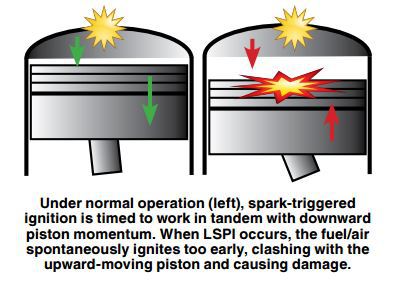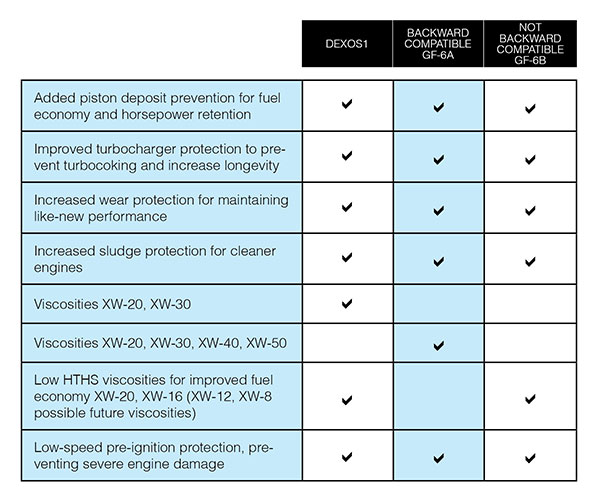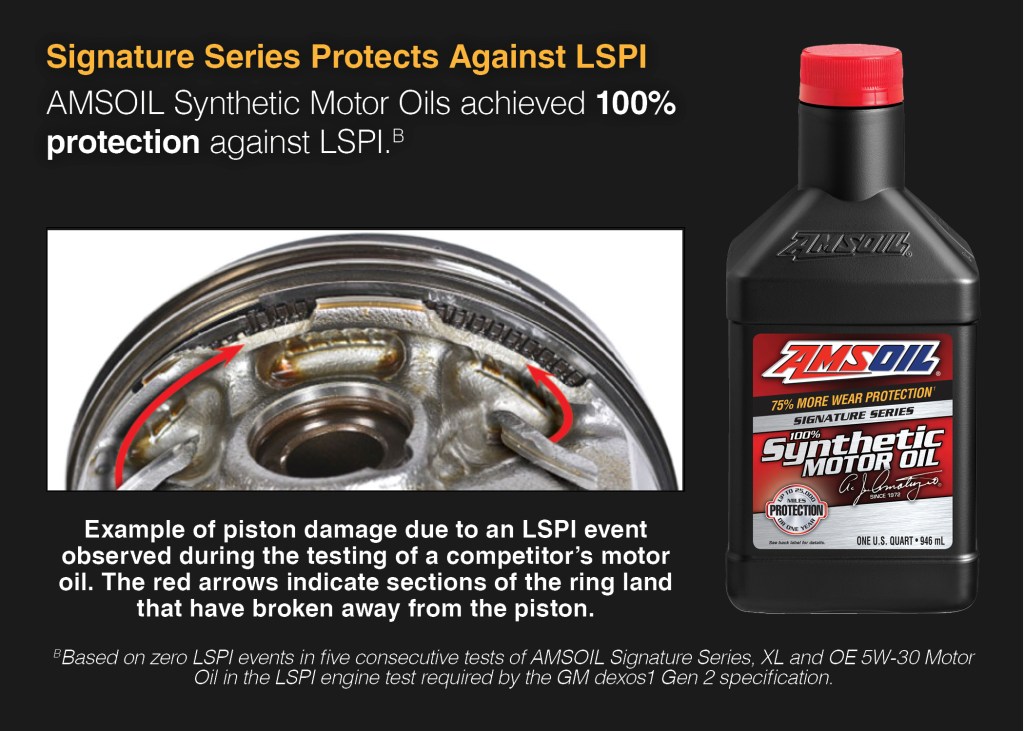ILSAC GF-6, API SP & dexos: New Oil Specifications
As engine-operating conditions grow more severe, so do the demands placed on your motor oil. Hence the need for updated oil specifications, like ILSAC GF-6, API SP and GM dexos1 Gen 2.
New engine hardware such as turbochargers, direct injection and variable valve timing (VVT) place increased stress on your engine oil. This, in turn, has led to the introduction of more strict more oil specifications.
Here’s what we’re going to cover:
- How strict fuel-economy standards increase engine stress
- What is LSPI (low-speed pre-ignition)?
- How motor oil helps prevent LSPI
- ILSAC GF-6, API SP and GM dexos
- Do AMSOIL synthetic motor oils meet GM dexos, ILSAC GF-6 and API SP specs?

Improved fuel economy
Corporate Average Fuel Economy (CAFE) standards require a fleet-wide average of about 40 mpg by 2026 in the United States.
To meet these requirements the automotive industry has focused on smaller, more fuel-efficient engines. In fact, most new vehicles now feature gasoline direct-injection (GDI), a turbocharger or both (T-GDI).
Severe operating conditions
Smaller, more-efficient engines that make the power and torque of higher-displacement engines undergo more severe operating conditions that can lead to…
- Severe engine knock, also called low-speed pre-ignition (LSPI)
- Increased engine temperatures
- Compromised fuel injectors
- Increased wear and deposits if the oil isn’t up to snuff
The biggest motor-oil-related challenge on the horizon is LSPI, which can destroy pistons and connecting rods.
LSPI can cause cracked pistons and rods
LSPI is the spontaneous ignition of the fuel/air mixture before spark-triggered ignition.
It is another version of pre-ignition. Pre-ignition (engine knock) has been around since the beginning of internal combustion engines.
LSPI, however, occurs under low-speed, high-torque conditions, such as taking off from a stoplight in T-GDI engines.
This scenario can create conditions where the fuel/air ignites too early in the combustion cycle, throwing off the engine’s timing.
The expanding combustion charge collides with the piston as it’s moving up the cylinder, potentially destroying the pistons or connecting rods.
Oil can help prevent LSPI
Experts suggest the cause is due in part to oil/fuel droplets or deposits in the cylinder igniting randomly. The droplets and deposits contain enough heat to ignite the air/fuel mixture before spark-triggered ignition.
Oil formulation can play a role in reducing LSPI.
Certain motor oil ingredients can promote LSPI, while others can help reduce it. It’s tempting to think, “Well, dump a bunch of ingredients into your formulations that help reduce LSPI.” But some ingredients that help reduce LSPI have been limited over the years in motor oil formulations for other reasons.
It truly is a scientific balancing act confronting oil formulators. It’s no easy task to formulate motor oils that deliver excellent wear protection, resist the increased heat of turbocharged engines, prevent deposits, act as a hydraulic fluid and, now, combat LSPI.
The performance of the entire formulation – not just one or two ingredients – is what counts.
ILSAC GF-6, API SP and GM dexos
Next-generation motor oils need to pass an LSPI test to meet these new demands.
General Motors was first out of the gate and required oils to pass its own LSPI test. Its GM dexos1 Gen 2 specification took effect Aug. 31, 2017.
The latest American Petroleum Institute (API) specification, API SP, took effect in May 2020. As did ILSAC GF-6, the latest spec from the International Lubricants Standardization and Approval Committee. For the most part, it mirrors API specifications.
ILSAC has set a new precedent in the passenger-car motor oil market by splitting its specification into two parts. One of the main differences between the two specifications is compatibility.
See the chart below. Both versions focus on wear protection, prevention of LSPI and improved engine cleanliness. However, GF-6B features a more stringent fuel economy test.
Engine oils can easily be identified as ILSAC GF-6A or 6B by the API emblem on the front label of the packaging. A shield represents the GF-6B specification, while the traditional starburst indicates a GF-6A product.
Both ILSAC specifications meet the industry-standard API SP specification which is most commonly found in owners’ manuals.
Relax…for now
For now, you don’t have to worry too much about LSPI.
Your vehicle’s computer is programmed to avoid operating conditions that lead to LSPI. But, operating your engine under those conditions does promise fuel economy gains.
AMSOIL meets the latest specs
AMSOIL synthetic motor oils meet or exceed the latest industry standards, including ILSAC GF-6, API SP and GM dexos1 Gen 2.
You can safely use our synthetic motor oils in engines that call for those specifications.
In fact, AMSOIL achieved 100 percent protection against LSPI in the engine test required by GM’s dexos1 Gen 2 specification.*
*Based on independent testing of Signature Series 5W-30, XL 5W-30 and OE 5W-30 in the LSPI engine test as required for the GM dexos1® Gen 2 specification.




